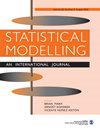客人编辑
IF 1.2
4区 数学
Q2 STATISTICS & PROBABILITY
引用次数: 0
摘要
本杂志的主要目标,统计建模,处理原始论文,认为统计建模作为统计学习的基本工具,无论是方法和应用。本期特刊,专门讨论生存分析中联合模型的贝叶斯推理,完全是受这个想法的启发。生存关节模型解释了复杂的结构建模。通常,感兴趣的结果是事件的时间,可以与其他类型的信息联合分析,以改进推理并更好地了解所研究的科学问题。通常,纵向输入与时间到事件数据联合建模,以允许在生存模型中包含时间协变量,但联合建模可以扩展到处理其他类型的数据,如空间观测。此外,联合模型也适用于处理具有不可忽略的缺失模式的纵向情景,这些模式可以用生存工具来描述。贝叶斯推理为生存数据联合模型提供了一个灵活而有吸引力的概念框架,主要是因为其特殊的概率概念允许用概率术语量化所研究问题中所有不确定性的来源,无论是否可观察到,并使用贝叶斯定理在获得更多相关信息时顺序更新概率。复杂模型的贝叶斯计算并不容易。这个主题在贝叶斯生存联合模型的框架中尤为重要,因为它们的实际实现产生了涉及新问题和挑战的新计算场景。这期特刊包含八篇文章,其中包括模型实现的新建议,方法的发展以及有趣的实际应用。虽然本刊的大多数论文都是方法论的,但它们都有一个特殊的部分,其中所提出的方法应用于实际问题,通常来自医学背景。下面,我们将简要介绍本期特刊中不同的作品。Beesley和Taylor的概念框架是多状态模型,这是一类随机过程,用于解释个体在时间上可能经历不同事件的事件历史数据。本文的重点是模型选择,这是多状态模型的一个关键主题,因为它的规范中有大量的参数,而由于数据缺失、高度相关的预测因子的存在和复杂的分层参数关系而产生的复杂模式加剧了模型选择。模型选择是基于收缩方法,贝叶斯方法解决通过规范的先验分布。考虑了马蹄形先验,以及根据两个正态分布的混合定义的spike和slab先验,以及点质量为零的spike的特殊情况。这些建议分别讨论了前列腺癌和头颈癌患者治疗的疾病-死亡模型和广义多状态治愈模型。本文章由计算机程序翻译,如有差异,请以英文原文为准。
Guest Editorial
The main objective of this journal, Statistical Modelling, deals with original papers which consider statistical modelling as a fundamental tool for statistical learning, both methodological and applied. This special issue, devoted to Bayesian Inference for Joint Models in Survival Analysis, has been entirely inspired by this idea. Survival joint models account for complex structured modelling. Typically, the outcomes of interest are times-to-event which can be jointly analysed with other type of information in order to improve inference and gain a better insight on the scientific question under study. Usually, longitudinal input is modelled jointly with time-to-event data to allow the inclusion of temporal covariates in the survival model, but joint modelling can be extended to deal with other types of data such as spatial observations. In addition, joint models are also suitable for dealing with longitudinal scenarios with non-ignorable missing patterns which can be described in terms of survival tools. Bayesian inference offers a flexible and attractive conceptual framework to joint models of survival data mainly due to its special conception of probability that allows to quantify in probabilistic terms all the sources of uncertainty, observable or not, in the problem under study, and the use of Bayes’ theorem to sequentially update probabilities as more relevant information is obtained. Bayes computation for complex models is not easy. This topic is particularly important in the framework of Bayesian survival joint models because their practical implementation generates new computational scenarios that involve novel questions and challenges. This special issue contains eight articles which include new proposals for model implementation, methodological developments as well as interesting practical applications. Although most of the papers in this issue are methodological, all of them have a special section in which the proposed methodology is applied to a real problem, usually coming from medical contexts. Below, we briefly present the different works in this special issue. The conceptual framework of Beesley and Taylor is multistate models, a class of stochastic processes which account for event history data with individuals who may experience different events in time. This article focuses on model selection, a key topic in multistate models due to the high number of parameters in its specification which are exacerbated by complicated patterns derived from data missingness, the presence of highly correlated predictors, and complex hierarchical parameter relationships. Model selection is based on shrinkage methods that Bayesian methodology addresses through the specification of prior distributions. Horseshoe priors, and spike and slab priors defined in terms of a mixture of two normal distributions and the particular case of a spike with point mass at zero are considered. These proposals are discussed for an illness-and-death model and a generalized multistate cure model for patients treated for prostate cancer and for head and neck cancer, respectively.
求助全文
通过发布文献求助,成功后即可免费获取论文全文。
去求助
来源期刊

Statistical Modelling
数学-统计学与概率论
CiteScore
2.20
自引率
0.00%
发文量
16
审稿时长
>12 weeks
期刊介绍:
The primary aim of the journal is to publish original and high-quality articles that recognize statistical modelling as the general framework for the application of statistical ideas. Submissions must reflect important developments, extensions, and applications in statistical modelling. The journal also encourages submissions that describe scientifically interesting, complex or novel statistical modelling aspects from a wide diversity of disciplines, and submissions that embrace the diversity of applied statistical modelling.
 求助内容:
求助内容: 应助结果提醒方式:
应助结果提醒方式:


